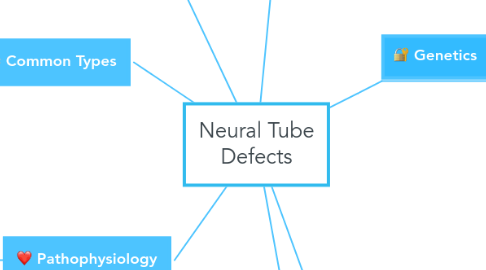
1. Diagnostic Testing
1.1. Prenatally
1.2. Ultrasound
1.2.1. An ultrasound done at 8-14 weeks can detect spina bifida if severe
1.2.2. An anomaly scan is a scan to detect physical problems. Usually done at 19-20 weeks
1.3. Elevation in alpha-fetaprotein levels in amniotic fluid
2. Common Types
2.1. Anencephaly: Partial or complete absence of cranial vault and calvarium, and partial or complete absence of cranial hemispheres.
2.2. Spina Bifida: is the protrusion of spinal tissue through the vertebral column.
2.3. Encephalocele: Herniation of various amounts of brain and meninges through a defect in the skull.
3. Pathophysiology
3.1. A defect in the closure or subsequent reopening of the neural tube.
3.1.1. The neural tube is a primitive tissue structure which develops into a structure of bones, tissue and nerves known as the spine as the embryo grows
3.2. Occur during first month of first trimester
4. Treatments
4.1. For Spina Bifida, surgery may be done in utero to minimize the defect. Ongoing treatments may include repeated surgeries, medications, physical and behavioral therapy
4.1.1. Spina Bifida Occulta is the mildest form of the defect and children often don't require treatment
5. Prevalence
5.1. Occur in 0.5-2 of every 1,000 pregnancies
5.2. Prevalence varies among populations: Chinese pregnancies 6 or higher per 1000 births
6. Risk Factors
6.1. Diet low in folic acid
6.1.1. It's estimated that 50%-70% of NTDs can be avoided by dietary folic acid supplementation
6.1.2. It is recommended that women of reproductive age take 0.4 mg of folic acid each day.
6.2. Maternal Obesity
6.3. Antiepileptic medication
6.4. Type 1 Diabetes
7. Genetics
7.1. NTDs arise from both genetic and environmental factors.
7.2. Empirical recurrence risk for siblings of affected people are 2%-5%
7.2.1. This risk increases with additional affected siblings.
7.3. Some chromosomal risks associated with NTDs include Trisomy 7, 8, 9, 13,14, 15,18, aneuploidy, triploidy and tetraploidy
7.3.1. Anueploidy: Cells that do not contain a multiple of 23 chromosomes. Triploidy: A zygote having 3 copies of each chromosome instead of 2. Tetraploidy: Euploid cells with 92 chromosomes.

